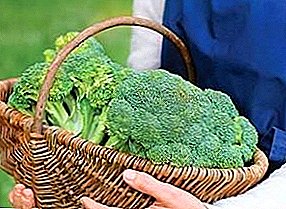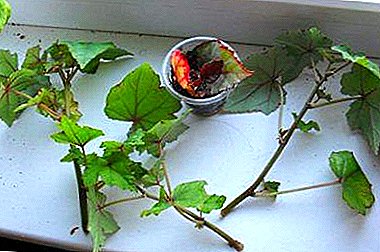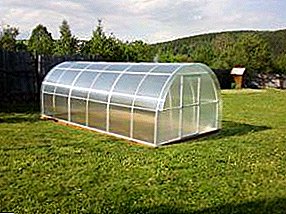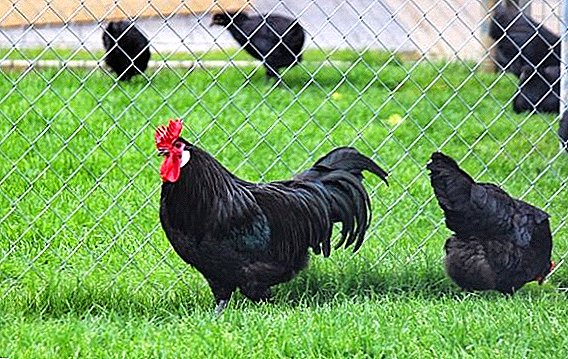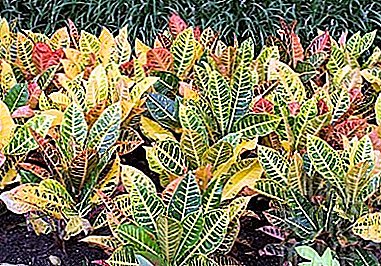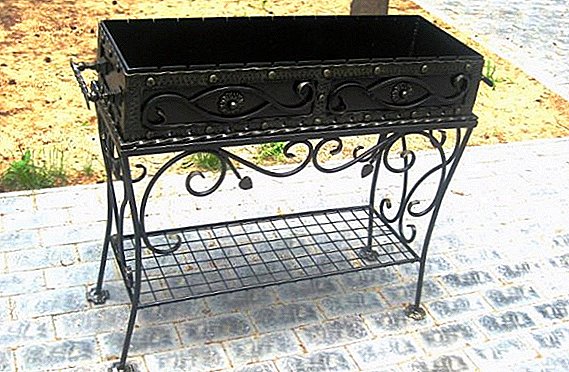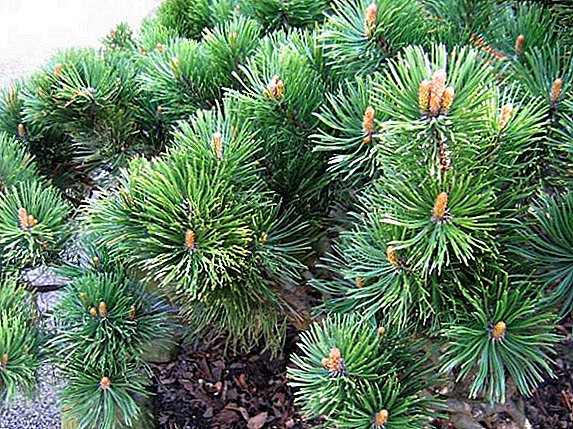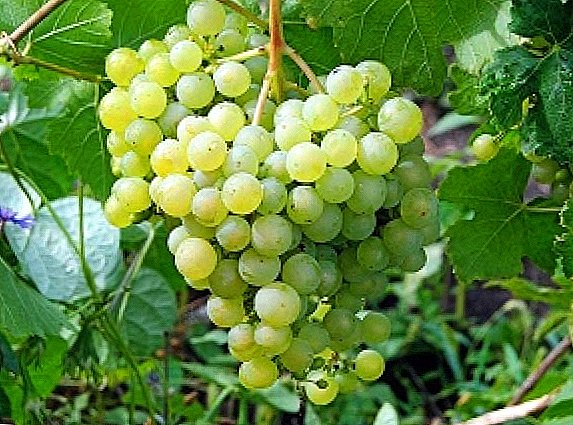
The table grape varieties are distinguished by exquisite taste and magnificent appearance.
It is impossible to pass past ripe ripe clusters without putting a berry in your mouth.
And the amber color and amazing taste of large berries of “Alyosha” will not leave anyone indifferent.
Variety description
Grapes "Aleshenkin" can also be found under the name "Alyosha" or "No. 328". It belongs to table varieties and is an excellent example for viticulture, both in taste and in its external characteristics. It takes its origin from crossing a mixture of pollen from varieties of the East with the grapes "Madeleine Anzhevin", from which it took a large number of worthy characteristics.
Features grade

Bushes are characterized by strong growth. Leaves of medium size, dark green color and a glossy mid-dissected surface, differ from other varieties in a five-lobed form. Most often, the shoot has two inflorescences. Flower bisexual. Fruit buds on the vine are laid from year to year. Cuttings take root fairly well in the new place and quickly take root. The shoots have a good level of aging, and the sleeves of grapes have a fruiting period of up to 6 years.
Bunches
Clusters of this variety most often have conical shaperarely branched, slightly loose. The weight is very large, some specimens reach two kilograms, while the weight of the average bunch is about 500g. The average weight of a berry is 4.5g. Vines of light amber color, with a slight wax coating, slightly oval.
The flesh is juicy, sweet, pleasant taste and crispy. Sugar content of juice reaches 20%, acidity - 7g / l. According to the tasting scale, the taste rating of the Aleshenkin variety reaches 8.8 points. Brush this grape has up to 40% of berries without seeds.
Yield
This type of grape belongs to high-yielding varieties. With one adult bush can collect up to 25 kg of ripe bunches. In order for the vine to fruit successfully from year to year, it is necessary to follow all the basic rules for the care of the vineyard, which we will discuss below.
Term ripening
The grapes "Aleshenkin" refers to very early varieties, its ripening period does not exceed 118 days with a CAT of at least 2000 ° C (the sum of active temperatures is the summation of all average daily temperatures for a certain segment of the season). Usually, the harvest can already be collected from the last days of July until the end of the summer.
Virtues
The main advantages of the "Aleshenkin" variety are high fruitfulness, amazing taste, a small amount of seeds in the berries, good rooting of cuttings and a good ripening of the vine even in bad years.

disadvantages
The main disadvantage of the "Aleshenkin" variety is the low resistance to frost of the stem of grapes, which is located underground. That is why this species is recommended to be vaccinated to frost-resistant stocks. But the part of the vine, which is located above the soil surface, has a fairly high tolerance of winter frosts. Ripe brushes have a high percentage of pea so they need to be processed using a growth stimulator. It has moderate resistance to fungal diseases.
Landing features
Although grapes are considered to be an unpretentious crop that can grow in different conditions, but still, it is worth paying attention to the fact that this bush likes light and warm places, and, also, reacts poorly to excess moisture in the soil. Of course, in the wild, this crop also grows on poor land, but if you want to achieve a good harvest and a long life for your vineyard, it will be useful to analyze the soil before planting the cuttings.
It is simply necessary to find out exactly which composition on the plot you choose, because the mineral component is very important for the quality growth of the vineyard. When, if the soil contains a lot of claythen an additional layer of drainage is needed, but if a peat field prevails on the site, then this soil should be diluted with sand. In areas with excess sand is practiced mixing in the ground compost or humus.
Needs to be avoided - these are salt marshes and marshlands. In such conditions, the grapes die.
We have dealt with the soil, now it’s time to choose place on the plot where the vineyard will be broken. An ideal option would be a gentle slope facing south or south-west. If there is no such option for planting vines, then choose a location near the wall of the building.
A building built of stone will give away its warmth to a growing vineyard. It is not allowed to plant bushes in areas with a high level of groundwater and cold air stagnation. When a plot and a place for planting a vineyard on it are determined, it is required to prepare the ground. To do this, you need to dig up the area for two weeks before the possible landing, and the soil with excessive acidity mixed with lime (200g / 1kv.m plot).

Since the ground part of the grapes "Aleshenkin" very badly tolerates frosts, it needs to be planted on frost-resistant stocks and planted in spring, so that the vine will strengthen enough in winter at a new place and the root system of the bush will grow well. So, it is already quite warm, the soil is heated and prepared, the place is chosen, you can start and planting bushes.
• we will begin preparation of holes for cuttings, the recommended value is 85-85-85 cm;
• We pour drainage into the excavated cavity, which may consist of rubble, gravel or other small pebbles. The usual drainage thickness is 10 cm, but it can be more if the groundwater is closely located;
• in the middle of the hole we fix the support (a peg or thick reinforcement), and fill the drainage layer with earth and a layer of fertilizer in proportion: three manure buckets or compost / 100 g of potassium salt / a little wood ash / about 300 g of superphosphates;
• thoroughly water the landing pit;
• we fill up with earth to fill 1/3 of the hollows;
• around the peg we make a mound of earth and fasten a sapling;
• we straighten the roots at the bottom of the dimple and fill it up to the top with the ground so that the level of vaccination or the place of branch of the shoots are higher by 3 cm above the level of the soil;
• carefully, in order not to damage the roots, compact the ground with your hands;
• once again plentifully water;
• mulch the soil with peat or humus.
When choosing grapes for planting, pay attention to the one-or two-year bushes with healthy, developed roots and sufficiently mature shoots. Before planting, shorten the main roots at the bottom of the seedling to 15 cm. With poorly developed roots use slant landing techniquethat makes it possible to use all the nodules for germination. Prune the seedling itself, leaving up to four of the largest buds.

Place the prepared bush for planting in a container with water. Since the grapes "Aleshenkin" does not tolerate frosts on the lower part of the bush, it is recommended for him to dig a groove up to 50 cm in depth. Thus, the underground part of the grapes and the root system will be well deepened and will not undergo excessive freezing. Make sure that the distance between crops was about 1.5m, and the distance between rows of grapes - up to 2m.
If the grapes are planted along the wall of the building, the distance from the wall to the seedling is allowed to be about 50 cm, provided that the water flowing from the roof does not fall on the bushes. With the growth of grapes, all the climbing shoots are fixed on the fence made.
Landing dates
Planting time for this grape is better to choose spring. It is only necessary to wait for the land on the plot to dry up already and to warm up. In the south it is about the 15th of May, and in the north, a little later, at the end of May.
Care
To get a rich harvest and healthy bushes of grapes, it is necessary to organize the right care for the vine. Here are some features:
1. this variety is necessarily insulated for the winter, because it does not tolerate frosts;
2. requires crop rationing;
3. needs additional protection against fungal diseases and pests;
4. prefers spring planting of saplings;
5. needs a long or medium pruning;
6. Like other grape varieties, it is demanding of soil moisture and additional feeding.
Watering
After planting, the sapling needs abundant watering so that the root system will take root faster in a new place. When this happens, the excess moisture is no longer needed.
With the excess flow of water into the soil, the berries on the hands begin to burst, which impairs their appearance and commercial value.
The last abundant watering, which is called moisture-loading, is carried out in the fall, after harvesting, thereby preparing the vine for hibernation.
To improve the access of moisture to the root system, narrow grooves can be built, then the moisture will not spread around the bush. If, additionally, after irrigation, also loosen the ground, this will improve the access of air and retain moisture for a longer period. When scheduling watering should be aware of such features:
• air humidity and precipitation in the region;
• average daily temperature;
• the mineral composition of the soil on the site;
• proximity to groundwater.

Taking into account all the features, it can be concluded that the bushes planted on the sandstones are watered more often, and the grapes growing on heavy clay soils - less often and with plenty of water.
Mulching
What is soil mulching necessary for and what is it? If you need
• protect shrub roots from frost;
• contribute to better nutrition of the vine;
• keep moisture in the radius of the root system;
• suppress or completely prevent weed growth;
• on the slope where the shrub grows, reduce the leaching of soil around it;
• prevent the formation of a dense crust around the trunk, because it impedes the access of oxygen to the root system;
• to protect the roots and the underground part of the grapes from freezing during the period of severe cold, then use the method of soil mulching.
Spruce and pine paws, which perfectly protect against frost, create additional air circulation under the shelter, which prevents bacteria and mold on the grapes, can be used as mulch.
Also, organic fertilizers (rotted manure, humus and compost) are suitable, providing additional fertilizing to the plant roots during the winter period, fallen leaves (if it is not infected with pests or diseases), dry mowed grass, peat crumb, sawdust, reed and other materials . Mulching can be combined (consisting of several types of materials) and homogeneous.
• It is very important to know, mulching has a negative side in some cases. If you chose straw or sawdust as mulch, they should be composted in advance. Otherwise, a large amount of carbohydrates in them will increase the intake of nitrogen from the soil by microorganisms. Thereby depriving the root system of this necessary element. Adding an additional amount of nitrogen fertilizers will also help in this case.

Knowledgeable growers prefer to use mulch annually, because on the surface the soil is highly exposed to the environment: temperature changes, dryness, frost and precipitation. It should be remembered that when it is hot, the mulch mixes on the plot with the soil of the near-barrel circle, and when preparing the bush for the winter, it fits into the top layer of soil, thereby improving the nutrition of the root system.
• Insofar as the main advantage of mulching is to prevent the drying of the soil surfaceThis means that it is not advisable to use this agricultural method on excessively wetted soils. Its use is especially good in places that are too dry, as well as on sandy and light sandy soils.
Harboring
To avoid frost damage to the vine, it must be covered. Various materials are suitable for this purpose: old rags, oilcloth, earth, sawdust, needles, etc. The best option for shelter is pine and spruce branches, which provide free air circulation, which does not lead to grapes and, well warms the bush.
Pruning
Pruning of the vine of the considered grape variety should be carried out by a length of 8-10 buds, sometimes the average pruning of shoots by 5-6 buds is allowed. Since this grape variety is very good fruit, it must be subject to rationing. For what all weak shoots and twins shoots are cut.
Fertilizer
The most commonly used fertilizers for this variety are mineral (potash salt and superphosphate) and organic (wood ash, compost and humus). For the best results, it is recommended to feed liquid fertilizers during irrigation. You can use both root and foliar vines.
It is also interesting to read about the best white grapes
Protection
Since the grapes "Aleshenkin" has a low resistance to fungal diseases, it needs double treatment with systemic agents. As a protective means you can choose as safe for humans, biological preparations for pest control, and chemical - pesticides. The disadvantage of the first is the need for their weekly use, as well as the repetition of the processing of the vine after precipitation, which is economically costly and time consuming. The second disadvantage is the adverse effect on the human body. To reduce the level of toxicity, it is desirable to use low-toxic (IV degree) preparations for spraying. Many experienced growers use lime solution to protect the bushes.


